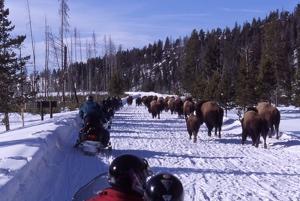The high heat of summer is settling in over the Rocky Mountains, and the issue of snowmobiles in Yellowstone and Grand Teton national parks still is in the news.
The latest is that the Environmental Protection Agency, as I told you back in January, disagrees with the conclusions reached in the draft Environmental Impact Statement prepared for the parks' winter use plan. To be more specific, the EPA in its formal comments to that DEIS says the parks' preference to allow as many as 720 snowmobiles in Yellowstone on a daily basis in winter "may not ensure adequate resource protection" and would result in much more pollution than the snowcoach-only alternative.
"The NPS's preferred alternative, when compared to another practicable alternative in the DEIS (Alt. 2, snowcoach only), would result in five times more carbon monoxide emissions and 17 times more hydrocarbon emissions," writes Kerrigan Clough, the deputy regional administrator of EPA Region 8. "This alternative also would double the acres in Yellowstone impacted by over-snow vehicle noise for more than 50 percent of the day."
There's more.
For instance, according to the EPA, the preferred alternative "would significantly exceed the previously established threshold for soundscape protection and exceed the threshold for air quality." More so, the alternative might lead to "significant levels of formaldehyde causing potential human health effects."
"If the NPS selects an alternative predicted to exceed resource protection thresholds, it would limit NPS's ability to address adverse effects that fall below the level of 'impairment,'" the letter continues.
Overall, the agency says, "the preferred alternative appears to lack adequate controls through the AMP (Adaptive Management Program) to ensure the protection of air quality, human health, natural soundscapes, and wildlife, and, therefore, EPA rates the preferred alternative 'Environmental concerns -- Insufficient Information.'
"Based on this rating, EPA believes that either the preferred alternative should be modified or a different alternative should be selected that meets the resource protections identified by the NPS."
The narrative goes on, but you get the picture. In a nutshell, the EPA thinks the Park Service has dropped the ball on designing a sound winter-use plan for Yellowstone and Grand Teton. If the DEIS were a term paper, one could easily see the EPA giving the Park Service a C- for a grade, if not an "incomplete."
There are even sections of the DEIS, says the EPA, that make unsubstantiated claims.
"The summary of impacts and Environmental Consequences state that under Alternative 2 (the snowcoach only alternative), 'opportunities to view wildlife and scenery may decrease.' The DEIS does not list any visitor survey or other research that indicates that snowcoaches reduce opportunities to view wildlife or scenery in any measurable sense. We recommend the Final EIS either include such references or delete this statement," the agency says.
"The DEIS also states that visitors would experience adverse impacts from 'snowcoach slowness.' Again, no studies or visitor surveys are cited in the DEIS to indicate that existing snowcoach visitors are adversely affected by snowcoach speed. When road conditions deteriorate, both snowmobiles and snowcoaches are forced to reduce their speed. If snowcoach speed becomes an issue, it may be possible to address this through improved technology over time."
It will indeed be interesting to see whether Yellowstone's planners take note of EPA's comments.




Add comment